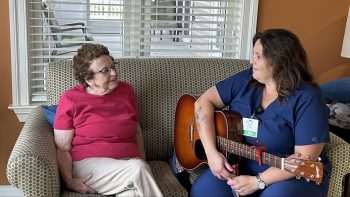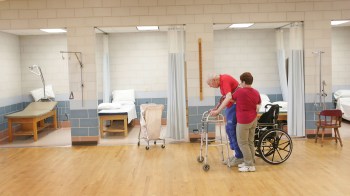
The economics of nursing homes (and paying for one)

This is just one of the stories from our “I’ve Always Wondered” series, where we tackle all of your questions about the world of business, no matter how big or small. Ever wondered if recycling is worth it? Or how store brands stack up against name brands? Check out more from the series here.
Listener Weston Monceaux from Crowville, Louisiana, asked:
I have seen nursing homes charge a patient thousands of dollars per month. But once their savings are depleted, the nursing homes are willing to accept the income from a patient’s Social Security check, which is typically $1,000 or less per month. I have wondered how the economics of this works.
About 15 years ago, Monceaux’s own grandmother was in a nursing home facility.
He noticed all the costs and surrounding paperwork that his mom had to keep up with on behalf of his grandma. That piqued his interest in nursing homes from a financial perspective — how they make a profit, their ownership structure and how the costs compare to at-home care.
“As I have gotten older and had my own hospital stays, I realize that around-the-clock medical care is expensive,” he said.
A majority of the 15,600 nursing homes in the U.S., about 70%, are for-profit. Most of them are privately owned, although their organizational structure can vary, with some owned by private equity companies, explained R. Tamara Konetzka, a public health sciences professor at the University of Chicago.
Christine E. Bishop, a professor of labor economics at Brandeis University, noted that many are part of a chain. “I think it’s pretty rare now to have just one nursing home owned by one small company,” she said.
The median cost of a private room in a U.S. nursing home is $8,821 a month, while a semiprivate room costs about $7,756, according to a cost of care survey from Genworth, which sells long-term care insurance.
At any point in time, Konetzka said, about two-thirds of nursing home residents are on Medicaid.
“It’s very hard for a facility to survive completely on private-pay revenues,” Konetzka said. “The vast majority of them depend on Medicaid and Medicare revenues. Medicare revenues come through the post-acute short-stay residents, and Medicaid revenues from the majority of long-stay residents.”
She noted that it’s very common for people to pay for nursing home care privately until they’re no longer able to afford it, which is when they can tap into the program.
“Medicaid doesn’t kick in until basically you’ve impoverished yourself,” Konetzka said. “Most states allow you to keep about $2,000 in assets, and your house often isn’t counted against that.”
Jim Wyler, a 54-year-old resident of Lindenhurst, New York, who takes care of his father’s finances, said that 70% of his father’s income goes toward his long-term stay at a nursing home, while Medicaid covers the rest.
“I think for the amount of care that my dad needs now, the cost is very reasonable,” Wyler said.
However, in general, nursing home care can be very expensive, which is why facilities will thoroughly investigate a potential resident’s finances before admitting her or him. Konetzka said that is especially true for nonprofits.
She noted that nonprofits, counterintuitively, actually have a slightly more lucrative revenue structure. That’s because they handle more complex care and rehab needs, as opposed to long stays, which are covered by Medicaid.
“Especially for the nonprofits, what they do is they really investigate people’s financial situations quite closely before they admit a new resident because they are, by law, not supposed to get rid of people just because they spend down to Medicaid,” Konetzka said.
Allison Heitzman, a 33-year-old resident of Botkins, Ohio, remembers trying to help her mother and father-in-law get Medicaid, which included detailing the assets they had and explaining why they had the money they did.
“It’s difficult to navigate, just proving everything,” she said. “They both were denied the first time, and then we had to go through the process all over again.”
Konetzka said that for-profit nursing homes tend to be located in lower-income neighborhoods with higher Medicaid use.
In recent years, the financial situation for many nursing homes has become particularly bleak. A report on skilled nursing facilities from 2019 found that for the first time in 34 years of analyzing the industry’s financial performance, the median operating margin was negative. In other words, roughly half of U.S. skilled nursing facilities were not operating profitably.
It’s an issue that the COVID-19 crisis has compounded, similarly to how it disrupted many other industries.
The 19th News reported that most say they may not be able to stay open another year due to costs associated with the pandemic. Ninety percent of nursing homes are currently operating at a loss, according to a joint news release from the American Health Care Association and the National Center for Assisted Living.
Although the $2 trillion federal relief package passed last year included about $21 billion earmarked for nursing homes, health care organizations say it isn’t enough. The AHCA and NCAL are now asking Congress to approve an additional $100 billion.
“The high cost of testing, [personal protection equipment] and staff support has caused tremendous strain on budgets,” the organizations wrote in their statement. “Staffing has been the top cost in response to COVID-19, with nine out of 10 nursing homes hiring additional staff and/or paying staff overtime. Admissions have declined, and the growing number of empty beds has fueled financial losses.”
Last year, The New York Times reported that nursing homes were already ill-equipped and understaffed to handle the crisis, a crunch fueled by the imperatives of private equity. Some investors would, for example, push nursing homes to buy products like drugs and ventilators “at above-market rates from other companies they owned.”
Bishop, of Brandeis, said that even before the crisis, nursing homes had been losing occupancy.
“That’s because all across the country, there is a stronger and stronger wish for people to stay in their own homes, or to stay in community living at all ages. And the state Medicaid programs, almost everywhere, are supporting more home-based and community-based services,” she said. “The people who are going into nursing homes are delaying going in because they are able to find more services at home. People are now experiencing shorter lengths of stay in the nursing home because they go in at the very end of their lives.”
There are also, it should be noted, demographic differences among nursing home residents. Generally, white Americans are more likely to use nursing home care compared to Black and Latinx Americans, who are more likely to depend on home care, according to Konetzka.
And among Asian Pacific Islanders, 42% provide care to older adults compared to 22% of the general population, according to the National Asian Pacific Center on Aging.
Comparing the costs of at-home and nursing home care can be difficult. For those with less need for care, Konetzka said, home care may be cheaper.
The median monthly cost for a home health aide is $4,576, according to Genworth, compared to the $7,756 to $8,821 for a room at a nursing home.
But if we’re talking about 24/7 care, that probably means the patient’s needs are great.
“When people have a high level of need, it’s unlikely to be cost-effective to have people at home instead, simply due to economies of scale,” Konetzka said. “Nursing homes have a structure and staff.”
Allison Heitzman, whose father is in a nursing home, said she knew it would be difficult on her mental well-being to care for him.
As people live longer and grapple with chronic disease and disability in their old age, Konetzka said, care in specialized facilities will never go away.
“Even the most progressive European countries that really emphasize home care still have nursing homes,” she said.
Bishop said it’s likely that some nursing homes will go out of business, especially with the COVID-19 crisis damaging their reputations, and we’ll lose some bed supply just when we need it.
But as states push for more home and community-based care, Konetzka said, the need for nursing home services may not increase as much as demographics would indicate.
Have a question you’ve always wondered about? Let us know using the form below.
There’s a lot happening in the world. Through it all, Marketplace is here for you.
You rely on Marketplace to break down the world’s events and tell you how it affects you in a fact-based, approachable way. We rely on your financial support to keep making that possible.
Your donation today powers the independent journalism that you rely on. For just $5/month, you can help sustain Marketplace so we can keep reporting on the things that matter to you.


















